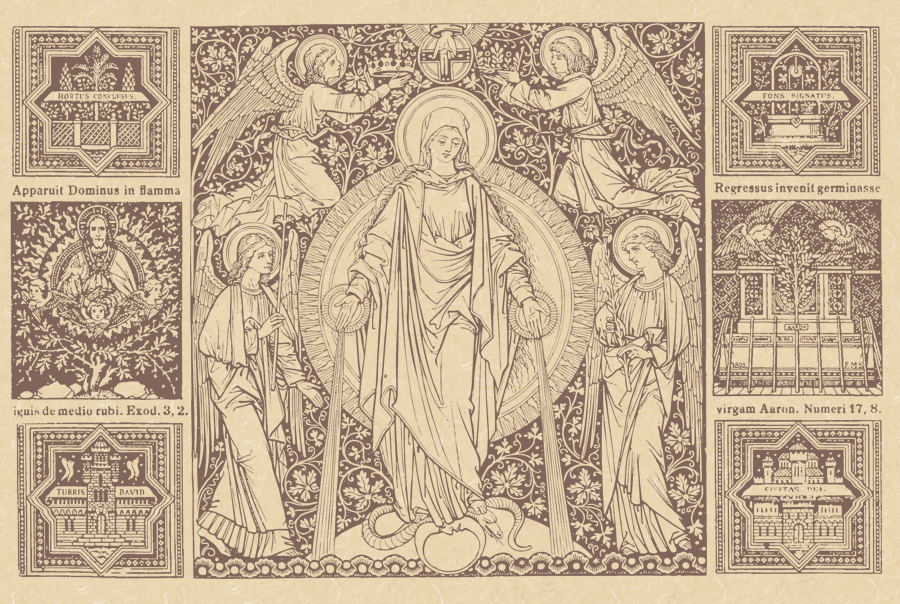Learn to Read.
The Ninety-Eighth Anniversary of the Second Apparition of Our Lady of Fatima.
The Tenth Saturday of Ordinary Time; the Memorial of the Immaculate Heart of the Blessed Virgin Mary; or, the Memorial of Saint Anthony of Padua, Priest & Doctor of the Church.*
Lessons from the primary feria, according to the ordinary form of the Roman Rite:
• II Corinthians 5: 14-21.
• Psalm 103: 1-4, 9-12.
• Matthew 5: 33-37.
[or, for the Mother of God:]
Lessons from the proper:
• Isaiah 61: 9-11.
• I Samuel 2: 1, 4-8 (in place of the psalm).
• Luke 2: 41-51.**
[or, for the saint:]
Lessons from the proper:
• Isaiah 61: 1-3.
• Psalm 89: 2-5, 21-22, 25, 27.
• Luke 10: 1-9.***
The Third Class Feast of Saint Anthony of Padua, Confessor & Doctor of the Church.†
First, third & fourth lessons from the common, second lesson from the proper, according to the extraordinary form of the Roman Rite:††
• II Timothy 4: 1-8.
• Psalm 36: 30-31.
• Psalm 111: 1-3.
• Matthew 5: 13-19
The Second Saturday of the Apostles Fast; the Feast of the Holy Martyr Aquilina; and, the Feast of Our Holy Father Triphyllus, Bishop of Leucosia.
Lessons from the pentecostarion, according to the typicon of the Byzantine-Ruthenian Rite:
• Romans 3: 28—4: 3.
• Matthew 7: 24—8: 4.
FatherVenditti.com
|
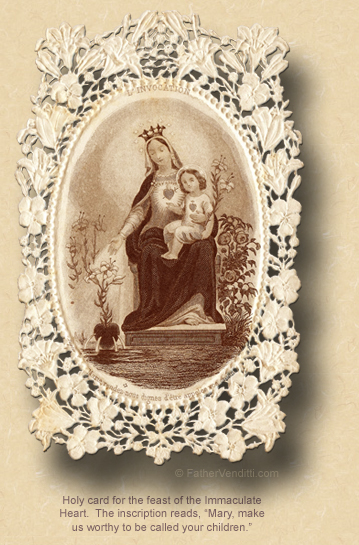 4:46 PM 6/13/2015 — Many years ago—I believe I had been a priest for two years at that time—I had been approached by a small community of religious sisters and asked if I would serve as retreat master for a group of college girls who were thinking about joining the community; but, the retreat they were asking me to preach would not be held in any one house of their community, but would, in fact, be a moving retreat: it would take place over the course of a whole month, during which I was to take these girls to various convents of the community throughout Italy and France. 4:46 PM 6/13/2015 — Many years ago—I believe I had been a priest for two years at that time—I had been approached by a small community of religious sisters and asked if I would serve as retreat master for a group of college girls who were thinking about joining the community; but, the retreat they were asking me to preach would not be held in any one house of their community, but would, in fact, be a moving retreat: it would take place over the course of a whole month, during which I was to take these girls to various convents of the community throughout Italy and France.
Despite being both small and new, this little group of nuns had a patron in Rome, a Cardinal who had taken them under his wing, and who had arranged for them to be given a number of beautiful convents previously owned by other religious orders but now abandoned. So, this little community of sisters, no more than ten years old, and having no more than thirty or forty members at the time, had possession of some of the most historical convents in Europe in the most auspicious locations. We spent two nights in what was once an old Dominican convent, the top floor of which looked down into the gardens of Castel Gandolfo, the pope's summer residence; we spent one night and a day in an old Salesian convent on the grounds of the Catacombs of Saint Callixtus just outside Rome, with access to the very chapel in which Pope Saint Sixtus II met his death and is now buried;—I offered Holy Mass on his tomb—we spent a few days in Milan, where I learned to offer the Holy Sacrifice according to the Ambrosian Rite, in the crypt of the very place where Saint Ambrose and his two deacons are entombed; we stayed in convents in Lourdes and Grenoble, in Assisi and in Rome itself. But, by far, one of the most beautiful places these nuns had a house we stayed in, was in north eastern Italy, on the shores of the Adriatic, in the city of Padua, the city of Saint Anthony.
The Basilica of Saint Anthony, where the saint's remains are entombed, is one of the most beautiful and moving places in all the Catholic world. Not only is the church magnificent architecturally, built in a kind of hybrid of Arabic, Romanesque and Byzantine styles, but also very moving spiritually. It's one of the few great pilgrimage destinations left in Europe where the tourism can't compete with the profound faith of those who come to pray to the patron saint of those who are lost. A lot of us make the mistake of thinking that Saint Anthony is the saint you pray to when you've lost your car keys; but, he's not the saint of lost things, but of lost people. And I don't mean by that people who are missing, but people whose life has no direction, who don't know where they're going or even where they are.
Today we gather to commemorate the Second Apparition of the Mother of God to Lucia, Jacinta and Marco at the Cova da Iria at Fatima on June 13th; and, while most of our speakers on our celebrations on the 13th of the month tend to speak very generally about the Fatima message, I thought it would be novel to speak specifically about the apparition being commemorated, which took place on this day ninety-eight years ago. 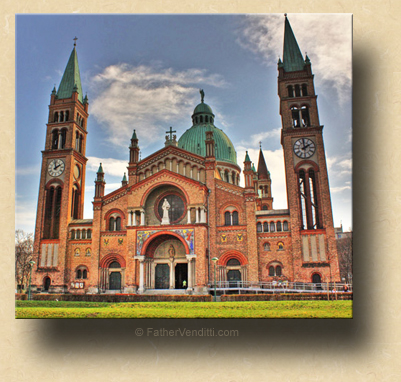 I mention my own trip to Padua, Italy, because of the integral role Saint Anthony and the celebration of his feast in Portugal played in that apparition. Although he died in Padua in 1231 and is buried there, Saint Anthony was born in Lisbon in 1195; in fact, in many places throughout Europe, he's not known as Saint Anthony of Padua, but Saint Anthony of Lisbon. When Pope Saint John Paul II visited Fatima he told the crowd there that Saint Anthony was not Saint Anthony of Padua, at which they all cheered deliriously; then he told them that he wasn't Saint Anthony of Lisbon either, and was met by stunned silence. But their silence turned to cheers again when he told them that the saint's true title should be “Saint Anthony of the Whole World.” I mention my own trip to Padua, Italy, because of the integral role Saint Anthony and the celebration of his feast in Portugal played in that apparition. Although he died in Padua in 1231 and is buried there, Saint Anthony was born in Lisbon in 1195; in fact, in many places throughout Europe, he's not known as Saint Anthony of Padua, but Saint Anthony of Lisbon. When Pope Saint John Paul II visited Fatima he told the crowd there that Saint Anthony was not Saint Anthony of Padua, at which they all cheered deliriously; then he told them that he wasn't Saint Anthony of Lisbon either, and was met by stunned silence. But their silence turned to cheers again when he told them that the saint's true title should be “Saint Anthony of the Whole World.”
So, travel back with me to Fatima, Portugal, on June 13th, 1917. Here's a trivia question for you: what is the name of the parish church in Fatima where Lucia was baptized and made her First Holy Communion? The parish Church of Saint Anthony. So, June 13th was a special day in Fatima long before Lucia was born: not only was it the feast of the Patron Saint of Portugal, it was also the patronal feast of the local parish. All the shops and businesses were closed, and everyone went to Holy Mass and spent the whole day in celebration. For children especially, the feast took on special significance, because—let's face it—we're talking about 1917. There was no television, no X-Box, no movies, no Dorney Park or Chucky Cheese's to visit; it was a very Catholic time, and the feasts of the Church were all the excitement they had to look forward to.  Lucia had already reported the Mother of God's first visit to her the previous month, though not everyone believed it, and knew that Lucia expected, on this day, to go to the Cova and meet once again with the one she knew only as “the beautiful lady”; so, everyone was interested to see if the child would actually leave the festivities behind to make her supposed appointment. Lucia had already reported the Mother of God's first visit to her the previous month, though not everyone believed it, and knew that Lucia expected, on this day, to go to the Cova and meet once again with the one she knew only as “the beautiful lady”; so, everyone was interested to see if the child would actually leave the festivities behind to make her supposed appointment.
Lucia got up very early that day. Because it was the feast of Saint Anthony, there was no shepherding of the flocks that day, so her intention was to go and gather in all the sheep and goats and corral them up so she could be on time for Mass at 10:00. She's in the process of doing this when, just before 8:00, her brother calls to her and tells her that a group of people from a town about twenty-five miles from Fatima had just shown up and wanted to see her. We don't know who these people were, exactly; they weren't locals from Fatima, but they had heard about what had been happening there, and wanted to go with Lucia to the Cova.
Now, by today's standards, Lucia would have been regarded as a rather ignorant little girl. She had no formal schooling and didn't know how to read or write; that was typical for peasant families in 1917. But, as someone who has more degrees than he could possibly need tacked on the end of his name, I can assure you that there is no greater obstacle to learning than going to school. Lucia dos Santos was no dummy. There was no way she could know who these people were, if they had come to Fatima out of genuine devotion or if they were, perhaps, looking for some sort of scandal to expose and so discredit her. But she doesn't need to know. She says to them, “Look, it's eight o'clock now; Mass is at ten. You want to come to the Cova with me? Fine, but we're all going to go to Mass first.” She makes them go to Church. She figures that, if they can sit through Holy Mass without bursting into flames, they must be OK.
It turns out she was right. They survive the Mass unscathed, and then make their way to the Cova, praying the Rosary as they go along. Lucia met up with her cousins, Francisco and Jacinta, at the Cova; and, when the Rosary was finished, the three children saw a light coming toward them, and then “the beautiful lady,” standing on the holmoak tree just like She had been in May.
The contents of the second apparition were almost identical to the first. Lucia began her conversation with the Mother of God with her usual question: “What do you want of me?” and, our Lady responded with a short list of requests, most of which She had already made in May: 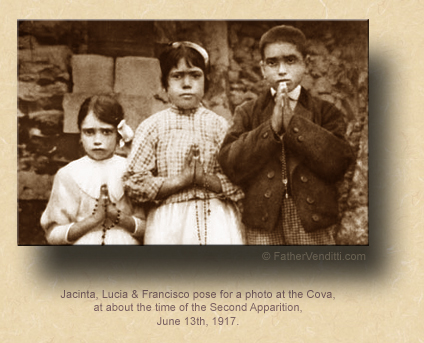 She told them that She wanted the children to come back the following month, She told them to pray the Rosary every day; but, there was one additional request that was new: She told Lucia that She wanted her to learn how to read. She told them that She wanted the children to come back the following month, She told them to pray the Rosary every day; but, there was one additional request that was new: She told Lucia that She wanted her to learn how to read.
Now, we've already discussed how education often has nothing to do with intelligence, and Lucia was the prime example of that; so, Lucia was a little confused by this request. One didn't have to know how to read to pray the Rosary; in fact, the Rosary, as you know, developed as a substitute to praying the Psalms for those who didn't know how to read. Why would the Mother of God want Lucia to learn how to do something which, in her day, was considered a luxury for the children of the rich? “The beautiful lady” doesn't explain to her why she wants her to do this, but only says that it has something to do with requests that she will make later in July. In retrospect, we know why our Lady asks this of her: because later, after her cousins are taken to heaven and she, herself, has entered religious life, Lucia would be given a message of peace that would need to be communicated to the whole world, and she won't be able to do that unless she knows how to read and write. And we also know that Lucia took this obligation very seriously, not only becoming a woman of letters, so to speak, but even mastering, toward the end of her life, the computer, which she used extensively to spread our Lady's message. Of course, she has no idea of this on June 13th, 1917, but she doesn't need to; all she needs to know is that “the beautiful lady” has requested it, and that's enough.
Now, there are some other things that happen during this second of the apparitions of “the beautiful lady”: Lucia asks to go to heaven; this is denied her for the reasons just mentioned, but she is told that her two cousins will be going to heaven soon. Lucia also asks our Lady for a cure for someone, and is told that the person will only be cured if he converts to the faith first, which I always thought was interesting; and, we could talk about what that means at some length.
But what I would like you to consider today are the ramifications of our Lady's request that Lucia learn how to read, and to consider it beyond the simple fact that she needs this skill to spread our Lady's message.
As I said, education in 1917 was considered a luxury. Certainly, many of the saints were known for their learning. The ancient Fathers of the Church wouldn't have been able to guide the Church through some of her most difficult periods had they not been versed in every language and known reams about philosophy and theology. We wouldn't even have a Bible today were it not for the mind of Saint Jerome, who was fluent in practically every language that existed in the fourth century. We wouldn't know the subtleties of original sin, and the consequences of denying it, were it not for the fact that Saint Augustine spent the better part of his youth studying every philosophical system there was and becoming the world's foremost master of rhetoric. And we wouldn't have a catechism, or understand the true nature of the Holy Eucharist, or even of the world around us, were it not for the erudition of a mind as immense as that of Saint Thomas Aquinas.
At the same time, most of the saints who form the basis for the devotion of the faithful are saints whose holiness has nothing at all to do with learning. The apparitions of the Mother of God at Lourdes were ultimately judged authentic by the Church primarily because young Bernadette Soubirous was unschooled, and couldn't possibly have known herself about the theological concept of the Immaculate Conception, a dogma which had not yet been defined, but was only beginning to be discussed in the highest echelons of the Church. 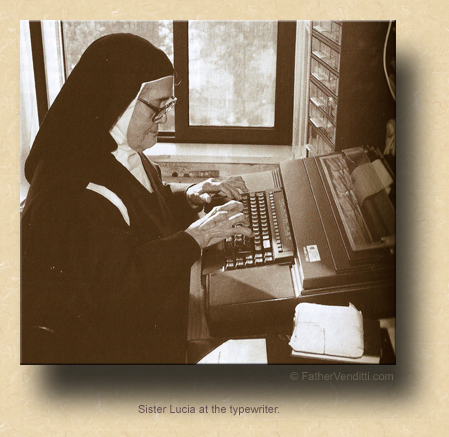 Saint Maria Goretti didn't need a high school diploma to sacrifice her life in defense of her purity. In point of fact, most of the saints that you and I pray to every day had never laid eyes on a school book or seen the inside of a classroom. Lucia dos Santos could have very easily become a saint without learning how to read; but, the Mother of God had other plans. Saint Maria Goretti didn't need a high school diploma to sacrifice her life in defense of her purity. In point of fact, most of the saints that you and I pray to every day had never laid eyes on a school book or seen the inside of a classroom. Lucia dos Santos could have very easily become a saint without learning how to read; but, the Mother of God had other plans.
Our Lady's request that Lucia learn to read was purely pragmatic: a message needed to be delivered, and the knowledge necessary to deliver it needed to be obtained; but, there is also something symbolically important for us to glean from this. One of the most frustrating penances a priest must learn to suffer in his life is learning to deal with devout Catholics who do not know or who completely misunderstand their own faith.
I'll never forget my first experience with this: I was a very young priest, assigned to my first parish, and one of the parishioners had just attended the wedding of her cousin, who was not Catholic, which had taken place in a Lutheran church. She came bouncing into church one Sunday, announcing to me with great ecumenical delight, that “the Lutheran Mass was so beautiful; it was just like ours!” So, I tried to explain to her that it wasn't “just like ours”; that while it may have looked “just like ours,” with the minister wearing the same vestments worn by a Catholic priest, and saying the same words said by a Catholic priest at Mass, the Lutheran minister was not a true priest because has not received the Sacrament of Holy Orders, handed down from the Apostles in an unbroken line, and therefore the bread and wine over which he prays and which he distributes to the people cannot be the Body and Blood of Jesus Christ. And the look of confusion on her face when I explained this to her told me that I might have well been speaking to her in Martian. And this was someone who had graduated from the parish school.
Just the other day, here at the Shrine, I had a conversation with someone who couldn't stop talking about this preacher she watches on TV, Joel Osteen, and how wonderful he is, and how inspiring he is, and how he's able to relate the Gospel of Jesus Christ to our everyday lives, and how the preaching in the Catholic Church is so boring by comparison. All of that is probably true—I may, in fact, be boring you to tears right now, for all I know—but so what? Joel Osteen can't absolve your sins. Joel Osteen can't give you the Blessed Body and Precious Blood of our Lord, God and Savior, Jesus Christ. Joel Osteen may be a very holy man—I don't know, I don't know the guy—but he is not a Catholic priest. By contrast, the pastor of your parish may be a very boring preacher. Your parish priest may be grumpy and not all that approachable; I know I was when I was a pastor, and—according to some people here—still am. Your parish priest may have a lot of faults and may not be all that holy, or at least reflect the kind of holiness you think he should. Let's face it: your parish priest may be a real jerk. But he's a priest. His hands consecrate the Body and Blood of Christ. One of the truths Saint Thomas Aquinas teaches us is that the holiness of the priest has nothing to do with the validity of his sacramental acts. 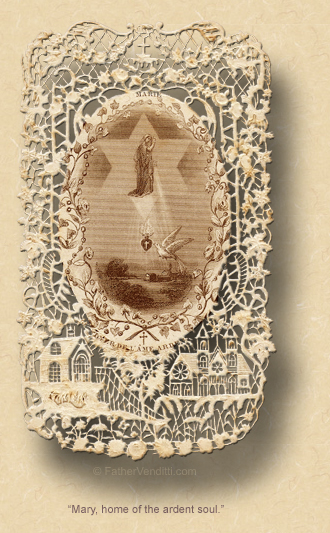 A person who is very holy but who is not a priest can try to give absolution, can try to say Mass, but nothing happens because he is not a priest; and, a priest who is a great sinner can still absolve you and can still give you the Body and Blood of Christ, because the priest does not do these things by his own power, but by the power of the Risen Christ given to him in ordination. But you can't understand that if you don't know the rudiments of the Catholic faith. A person who is very holy but who is not a priest can try to give absolution, can try to say Mass, but nothing happens because he is not a priest; and, a priest who is a great sinner can still absolve you and can still give you the Body and Blood of Christ, because the priest does not do these things by his own power, but by the power of the Risen Christ given to him in ordination. But you can't understand that if you don't know the rudiments of the Catholic faith.
Now, that's just one example. The sad fact is that the majority of the faithful that you see Sunday after Sunday, sitting next to you in the pews of your parish church, knows nothing about their own church and their own faith except what they hear on the evening news. And if you think you're going to get the truth there, then you really are a low-information Catholic.
Mary commands Lucia to learn how to read. In a certain sense, what our Blessed Mother says in these apparitions is very much like what our Lord says in the Gospels; and, by that I don't mean that they're said with the same authority, and Mary certainly didn't intend that they would be, but that everything said has a double meaning. In the Gospels, for example, whenever our Lord says something, there's always two meanings: there's what He intends for his audience at the time, whether it be the Pharisees in the Temple of Jerusalem, or the Samaritans at Sychar, or His own disciples on numerous occasions, but then there's what His words mean to us as individuals who read His words or hear them read in Church centuries later. For example, a couple of weeks ago, when we celebrated the Memorial of Saint Justin the Martyr, we read at Holy Mass our Lord's parable of the Vineyard. Now, to the Scribes and Pharisees who are hearing this story told to them by our Lord, the meaning is very clear: He's given them a lesson about the history of the Jewish people and the role His death and resurrection will play in the whole drama of salvation history, symbolized by the vineyard owner who goes away on a trip, and sends numerous servants back to collect his profits from the annual harvest, who represent the prophets of the Old Testament; but, these are all killed or driven away. So, the vineyard owner sends his own son, but even the son is killed. Our Lord ends the parable by asking the question: “And now, what will the owner of the vineyard do? He will come, and make an end of those vine-dressers, and give his vineyard to others” (Mark 12: 9 Knox). Our Lord, through this parable, was predicting His own death at the hands of His own people and, at the same time, explaining why salvation was going to be made available to the Gentiles.
But His message to us in this parable is very different: His message to us is that we must cultivate the vineyard of Grace sown into our souls by reason of our baptism, by which His death and resurrection are made active in us. He has given us new life through baptism. He has given us the Church and the sacraments as fountains of grace and life. He has given us the Gospel as a path to heaven. He has placed in our own hands the possibility of salvation and eternal life. He has sent us teachers to correct our faults, not only the prophets of old, but also the Fathers of the Church, the saints, the martyrs, the popes. Sometimes we listen, sometimes we don’t.  And the day will come when He will ask for an account of how well we have harvested the seeds that He has planted. And if there is no fruit, that will not be His fault, but ours; for just as the vineyard owner sent his son to collect the harvest, just as the Father sent Christ our God to collect the harvest of the covenant from the Jewish people, so again the Father will send the Son as King and Judge of the world. And He will ask us to show Him the lives of purity and virtue and holiness that we have reaped from the seeds of grace He has planted in us. And the day will come when He will ask for an account of how well we have harvested the seeds that He has planted. And if there is no fruit, that will not be His fault, but ours; for just as the vineyard owner sent his son to collect the harvest, just as the Father sent Christ our God to collect the harvest of the covenant from the Jewish people, so again the Father will send the Son as King and Judge of the world. And He will ask us to show Him the lives of purity and virtue and holiness that we have reaped from the seeds of grace He has planted in us.
The Mother of God, on June 13th, 1917, asked Lucia dos Santos, a girl who had never been to school, to learn how to read. Her immediate purpose—unknown to Lucia, as we said—was so that Lucia would be able to spread the vital message of peace in the world that had yet to be given. But what is our Lady saying to us in this request? I assume all of us here already know how to read; so, what does our Lady's request to Lucia mean to us? Does it not mean that we must learn our Catholic Faith as completely as possible? Does it not mean that we must learn to educate ourselves about the truths of our Faith? Does it not mean that we can't rely on some talking head on television to tell us what's going on in the Church, or in the mind of the pope? Does it not mean that we must learn to cultivate a knowledge of the Church and the Faith that comes from the Church herself? Does it not mean that we should cease to judge our priests for being boring or less than inspiring and realize that, because they are priests, they bring us Grace in the Sacraments in spite of all their personal shortcomings? Does it not mean that we must stop seeking priests in confession whom we think will tell us what we want to hear instead of telling us the truth, no matter how difficult the truth may be to hear? Does it not mean that we must learn to stand out from the crowd, to go against the grain, to muster the courage and spiritual maturity to live lives of purity and virtue and goodness in an age which rewards vice and materialism? Does it not mean, as Saint José Maria Escrivá once said, that we should strive to live in such a way that, when others see us act or hear us speak, they will say of us, “There goes someone who has read the life of Jesus Christ”?
So, as we gather here at our beautiful Shrine to commemorate the 98th Anniversary of the 2nd Apparition of our Lady of Fatima, I would suggest that we take for our meditation today three simple words spoken by our Lady—words often passed over—which, for our purposes, can be said to sum up the whole of the day's meaning: learn to read!

* Both memorials of the Immaculate Heart and Saint Anthony are obligatory; however, as they both fall today on the same day, the Memorial of the Immaculate Heart being a movable feast falling on the Saturday following the Second Sunday after Pentecost, they both become optional. As a consequence, the feria of the Second Saturday of Ordinary Time, which would ordinarily be displaced by either one, becomes available as well. It falls to the priest to choose the celebration.
The commemoration of the 98th Anniversary of the 2nd Apparition at Fatima is not a liturgical feast, but is a major celebration at the Shrine over which I have been given pastoral care, and is the occasion of this talk, which occured before Holy Mass. The homily at Mass, which was of the Immaculate Heart, was preached by another.
** Though these lessons are from the proper, only the third lesson must be used for this memorial; the others may be replaced by lessons from the common or the feria.
*** Though these lessons are from the proper, all of them may be replaced by lessons from the common or the feria.
† In the extraordinary form of the Roman Rite, the Second Class Feast of the Immaculate Heart of Mary is celebrated on August 22nd.
†† As indicated, the gradual psalm alone is proper to this feast; the other lessons, including the tract psalm, are all from the common, though in point of fact the gradual in both the proper and the common are, by coincidence, the same.
|
